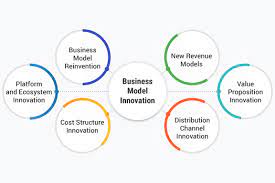In the ever-evolving landscape of business, the ability to innovate extends beyond products and services to the very core of an organization—the business model. Business model innovation is the creative process of reimagining how a company creates, delivers, and captures value. This article explores the art of business model innovation and how it can be a catalyst for sustained growth and competitive advantage.
Definition and Scope
Business model innovation involves making significant changes to one or more components of a company’s business model. This could include alterations to the value proposition, revenue streams, distribution channels, customer relationships, or key partnerships. It goes beyond incremental changes and embraces a holistic transformation of how a business operates.
Dynamic and Adaptive
Business model innovation is dynamic and adaptive. It responds to shifts in the market, emerging technologies, and changing customer preferences. Successful innovators continuously assess and refine their business models to stay ahead in a rapidly changing business environment.
Market Trends and Customer Insights
Identifying opportunities for business model innovation begins with a deep understanding of market trends and customer insights. Companies that closely monitor industry developments and listen to customer feedback are better positioned to identify areas for improvement and innovation.
Emerging Technologies
The integration of emerging technologies often presents opportunities for business model innovation. Whether it’s blockchain, artificial intelligence, or the Internet of Things, adopting new technologies can revolutionize how a business delivers value and interacts with customers.
Product-to-Service Transformation
Moving from a product-centric model to a service-oriented one is a common form of innovation. This shift focuses on providing solutions and experiences rather than selling standalone products, leading to new revenue streams and enhanced customer relationships.
Digital Transformation
Embracing digital transformation involves leveraging digital technologies to improve internal processes, enhance customer experiences, and create new business models. This may include the use of e-commerce, data analytics, and cloud computing.
Pilot Programs and Experimentation
Implementing business model innovation often involves pilot programs and experimentation. Companies may test new ideas in specific markets or segments before scaling up. This approach allows for learning, refinement, and minimizing the risks associated with large-scale changes.
Agile Methodologies
Adopting agile methodologies is crucial for successful business model innovation. Agile approaches, such as Scrum or Kanban, enable organizations to respond quickly to changing circumstances, iterate on ideas, and maintain flexibility throughout the innovation process.
Open Innovation
Business model innovation can be facilitated through open innovation—collaborating with external partners, startups, or industry experts. By tapping into external knowledge and resources, organizations can bring fresh perspectives and capabilities to their innovation efforts.
Strategic Partnerships
Building strategic partnerships can also drive business model innovation. Collaborating with complementary businesses or entering into alliances expands the range of value offerings and creates new opportunities for revenue generation.
Key Performance Indicators (KPIs)
Measuring the success of business model innovation requires defining and tracking key performance indicators. These metrics could include changes in revenue, customer satisfaction, market share, and the adoption rate of new products or services.
Feedback Loops
Establishing feedback loops is essential for ongoing improvement. Regularly seeking feedback from customers, employees, and other stakeholders provides valuable insights into the effectiveness of the new business model and areas that may need further refinement.
Cultural Resistance
Resistance to change is a common challenge in business model innovation. Addressing cultural resistance involves fostering a culture of innovation, providing education and training, and ensuring that employees understand the strategic rationale behind the changes.
Resource Allocation
Effective resource allocation is crucial. Allocating the right resources—financial, human, and technological—ensures that the innovation efforts have the support needed for successful implementation. Balancing short-term financial goals with long-term innovation objectives is key.
Netflix
Netflix’s transition from a DVD rental service to a streaming subscription model is a classic example of business model innovation. By adapting to changing consumer behavior and leveraging technology, Netflix revolutionized the entertainment industry.
Airbnb
Airbnb’s business model innovation transformed the hospitality sector by connecting travelers with unique, locally hosted accommodations. The platform’s success lies in redefining the value proposition and disrupting traditional lodging models.
Conclusion
The art of business model innovation requires a blend of creativity, strategic thinking, and adaptability. Organizations that embrace continuous innovation in how they create, deliver, and capture value are better positioned for long-term success. By understanding market trends, leveraging emerging technologies, experimenting with new ideas, fostering collaboration, measuring success, and overcoming challenges, businesses can unlock the transformative power of business model innovation. In a world where change is constant, the ability to innovate at the fundamental level of the business model is a hallmark of forward-thinking and resilient enterprises.

